
João Marcos Rosa
Genetic analyses helped researchers separate the pure population of the Alagoas Curassow (foreground) from the hybrid birds (out of focus in background)João Marcos RosaLast sighted nearly 40 years ago in Atlantic Forest remnants in the state of Alagoas, the extremely rare Pauxi mitu is considered to be extinct in the wild. This bird species, which grows as large as 90 centimeters (cm) in length and displays plumage in shades of bluish-black, fell victim to hunters in search of its succulent meat. There has also been a drastic shrinkage of its habitat to less than 2% of its original expanse. Commonly known as the Alagoas Curassow, this gallinaceous bird would have disappeared completely were it not for the efforts of three breeders, with the help of biologists, who focused on breeding the bird in captivity. Fortunately, the initiative has been successful. Starting from only one male and two females from the wild—the last specimens caught in the forests of Alagoas in 1979—the population of the bird has revived and now numbers about 230 specimens in captivity.
One important detail that contributed to the success of the endeavor has paradoxically developed into a problem that needs to be overcome before the resuscitated species is reintroduced into the wild, which is expected to occur in the second half of 2017. Hybrid birds, which resulted from poorly controlled crossbreeding between the Alagoas Curassow and the Razor-billed Curassow (Pauxi tuberosa), a sister species that occurs in Amazonia, had been mixed with pure specimens of P. mitu in captivity. The complication began in 1990 as a product of the best intentions of Pedro Nardelli, the breeder who brought back from the Alagoan forest the last three Alagoas Curassows found in the wild—an initiative that saved the species from total extinction. In Nardelli’s aviary at the time were five males without mating partners among a population of 19 Alagoas Curassows kept in Nilópolis, on the outskirts of Rio de Janeiro. In order to give the males a chance to mate, the breeder decided to introduce female Razor-billed Curassows into the aviary. “I crossed the two species in order to ensure the continuation of the Alagoas Curassow lineage,” explains Nardelli, who is now 80.
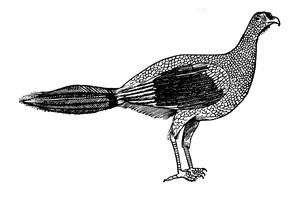
Reproduction from A preservação do mutum-de-alagoas, by Pedro Mário Nardelli
This 17th-century wood engraving is the first representation of the Alagoas CurassowReproduction from A preservação do mutum-de-alagoas, by Pedro Mário NardelliOver time, the bird population bred under human supervision began to encompass two types of Alagoas Curassow: pure specimens that had resulted from crosses between P. mitu males and females, and several hybrids that carried genetic material from the two species in different proportions. The exact record of which ones were pure and which were hybrids was ultimately lost in 1999, when Nardelli found himself forced to close his aviary. The existing 44 birds were then sent to two breeders in the state of Minas Gerais. “Since some hybrids have physical traits very similar to those of the pure individuals, you can’t differentiate them by morphology alone,” explains Luís Fábio Silveira, curator of the ornithology department at the Zoology Museum of the University of São Paulo (MZ-USP). “We had to develop a genetic approach to differentiate the two groups.”
The researchers used two different techniques in molecular biology to separate the pure from the hybrid specimens, as described in a paper accepted for publication in the scientific journal PLOS One. The first technique analyzed the mitochondrial DNA, a type of genetic material inherited only from the maternal lineage. Since many hybrids have Razor-billed Curassow females among their ancestors, this type of approach can detect the mixed-ancestry birds having that genetic profile. The second technique was a study of 14 microsatellites—small repeated DNA segments that are used in population genetics to determine the degree of relationship between individuals, groups, species or subspecies. Some variations of microsatellites are species-specific. If they are found in another species, this indicates the presence of a bird with some degree of hybridism. By combining the two methodologies, it was possible to identify a group of 66 pure Alagoas Curassows—coincidentally 33 pairs—among the 148 specimens that were alive between 2008 and 2012 in the two Minas Gerais aviaries.
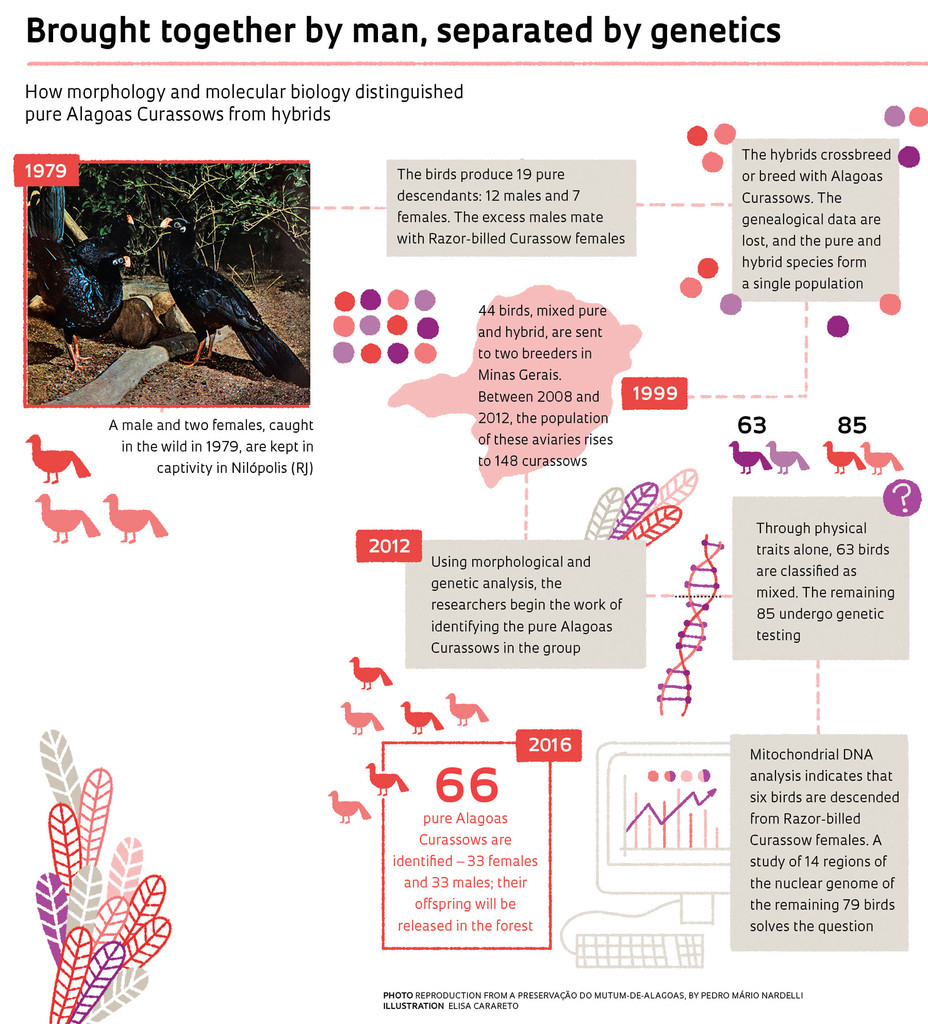 The process of determining a population’s level of purity through molecular analysis is not infallible, but the authors of the paper say the approach is very reliable. “The chance that we erred in identifying a pure bird is only 2%,” comments biologist Mercival Roberto Francisco of the Federal University of São Carlos (UFSCar), Sorocaba campus, who coordinated the genetics portion of the studies. “That’s a very low figure, given the fact that in the scientific literature, the chance of error in similar studies is 5%.” Since it was identified, the group of pure birds has been kept separate. They are of relatively advanced age, between 16 and 20 years old. Luckily, the Alagoas Curassow lives up to 30 years in captivity and remains reproductive during much of its life span. “We now have 18 young pairs of pure Alagoas Curassows that were born in the past three years,” says Roberto Azeredo, owner of the breeding facility CRAX – Sociedade de Pesquisa a Fauna Silvestre [Center for Wild Animal Research] in Contagem, a city in the Belo Horizonte metropolitan region.
The process of determining a population’s level of purity through molecular analysis is not infallible, but the authors of the paper say the approach is very reliable. “The chance that we erred in identifying a pure bird is only 2%,” comments biologist Mercival Roberto Francisco of the Federal University of São Carlos (UFSCar), Sorocaba campus, who coordinated the genetics portion of the studies. “That’s a very low figure, given the fact that in the scientific literature, the chance of error in similar studies is 5%.” Since it was identified, the group of pure birds has been kept separate. They are of relatively advanced age, between 16 and 20 years old. Luckily, the Alagoas Curassow lives up to 30 years in captivity and remains reproductive during much of its life span. “We now have 18 young pairs of pure Alagoas Curassows that were born in the past three years,” says Roberto Azeredo, owner of the breeding facility CRAX – Sociedade de Pesquisa a Fauna Silvestre [Center for Wild Animal Research] in Contagem, a city in the Belo Horizonte metropolitan region.
As a keen enthusiast of cracids—the family of gallinaceous birds that includes curassows, piping guans, jacus and chachalacas, Azeredo is currently the person most knowledgeable about the habits of this Alagoan bird. About 90% of all living specimens of Alagoas Curassows, including the hybrids, are in his aviary; the remainder are in another aviary in Poços de Caldas. To find the perfect pair, he might spend hours watching the reactions of birds that are ready to mate. “Azeredo is able to discern when the female is not comfortable with the male, and to switch in one of those individuals in order to find the best pair,” comments Silveira of MZ-USP. “Without him, we wouldn’t have been able to breed so many curassows in captivity.” In recent years, after analyzing part of the DNA of all the birds raised in captivity, Francisco the biologist started sending Azeredo periodic suggestions for ideal pairs from the point of view of someone who wants to ensure the genetic diversity of the species. “The problem is that the birds don’t always agree with genetics,” the breeder jokes.
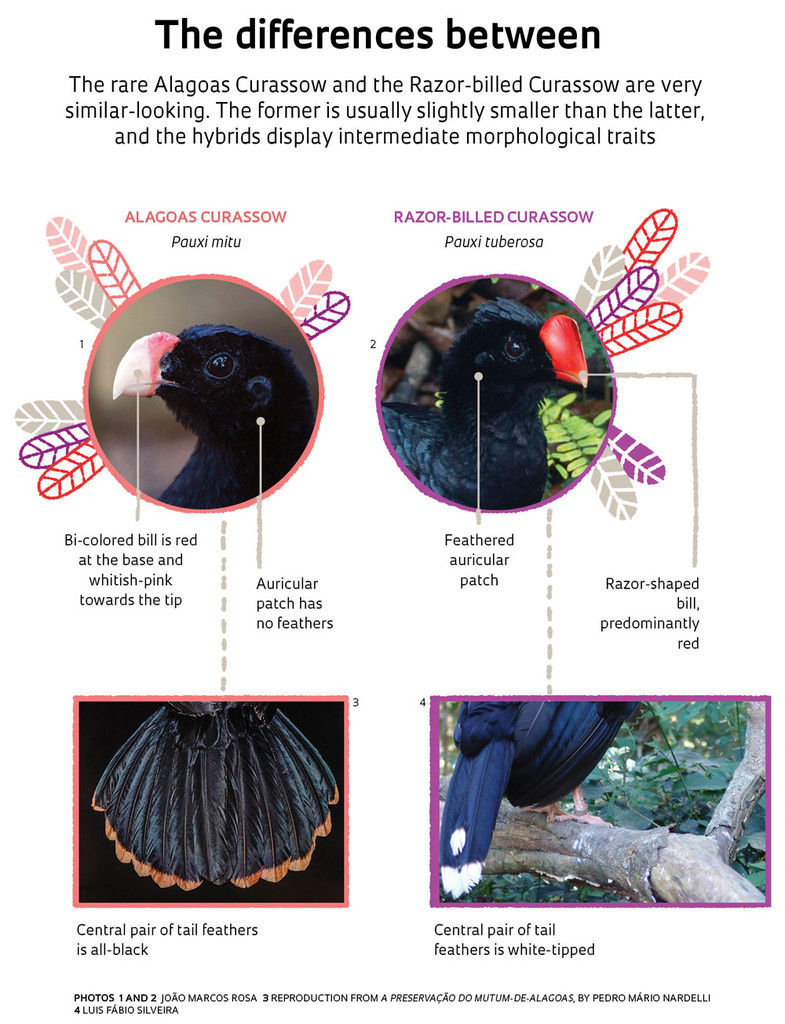 Azeredo, a former business manager, says the secret to his work is promoting sensible breeding. Alagoas Curassows usually live as pairs. “But sometimes they can be aggressive. In those cases, I only put the pair together in the aviary at breeding time,” he explains. A female generally enters reproductive age when it reaches three years. If it has been inseminated, it lays two eggs between September and November. Azeredo has abundant experience with cracids. Since the 1970s in his aviaries, he has been breeding specimens of the Red-billed Curassow (Crax blumenbachii), a species that is endangered but not in as critical a state as its Alagoan cousin. He pioneered the reintroduction of C. blumenbachii into the wild with great success. “Having an aviary is a good way to go broke blissfully,” says Azeredo, with his ever-present good humor.
Azeredo, a former business manager, says the secret to his work is promoting sensible breeding. Alagoas Curassows usually live as pairs. “But sometimes they can be aggressive. In those cases, I only put the pair together in the aviary at breeding time,” he explains. A female generally enters reproductive age when it reaches three years. If it has been inseminated, it lays two eggs between September and November. Azeredo has abundant experience with cracids. Since the 1970s in his aviaries, he has been breeding specimens of the Red-billed Curassow (Crax blumenbachii), a species that is endangered but not in as critical a state as its Alagoan cousin. He pioneered the reintroduction of C. blumenbachii into the wild with great success. “Having an aviary is a good way to go broke blissfully,” says Azeredo, with his ever-present good humor.
Genetic bottleneck
In their PLOS One paper, Francisco and Silveira point out that the history of the Alagoas Curassow is one of the most extreme cases of a genetic or population bottleneck ever documented in the scientific literature that had a happy ending. Despite having been reduced to just three specimens kept in captivity, at their most fragile moment a little more than 35 years ago, the bird escaped complete extinction with the help of humans. “The Mauritius Kestrel (Falco punctatus), once considered the world’s rarest bird, experienced a similar situation in 1974, when only four individuals remained,” Silveira says. The species, which grows to only 25 cm in length and is endemic to the Mauritius Islands archipelago in the Indian Ocean, nearly disappeared completely due to the gradual destruction of its habitat. Today, as a result of efforts by conservationists who boosted its reproduction in the wild and in captivity, the kestrel population has expanded to about 400 specimens. The case of the Chatham Islands Robin (Petroica traversi) of New Zealand was even more critical. “All of the approximately 280 individuals now living are thought to be descendants of just one pair that reproduced between 1979 and 1982,” Francisco notes.

John Maremootoo / Wikimedia Commons
The present-day population of the Mauritius Kestrel is descended from only four specimensJohn Maremootoo / Wikimedia CommonsThe most well-known Brazilian bird species that is probably extinct in the wild and survives only in captivity is the Spix’s Macaw (Cyanopsitta spixii). Originally endemic to the Caatinga scrublands of northern Bahia State, this macaw now numbers more than 50 specimens kept in Brazil and other countries. It has not, however, been returned to its habitat. According to the IUCN Red List maintained by the International Union for Conservation of Nature, there are currently 68 species of animals and plants that have disappeared from the wild but have been conserved in places maintained by humans. “It’s worthwhile to invest in these species,” Francisco says. “When we started our project, we were questioned about whether it was right to work with a species whose captive population might have no remaining pure specimens.”
Domesticated and tasty
The first reference to the Alagoas Curassow dates back to the 17th century. “This bird is easily domesticated; it likes to sit on a high perch like a peacock and it also climbs trees. Its meat is very tasty.” Thus ends the first description of the species, published in 1658 in the pages of the Historia Naturalis Brasiliae. The book was authored by German naturalist George Marcgrave, a member of the Dutch delegation brought to Brazil by Maurice of Nassau during the colonization of the Northeast in the first half of the 17th century. The book’s coauthor was Guilherme Piso. A wood engraving accompanied the description of the bird; it came from a slave, probably in Recife, and Marcgrave gave it the name mitu, a Tupi word used by the Indians to refer to that bird.
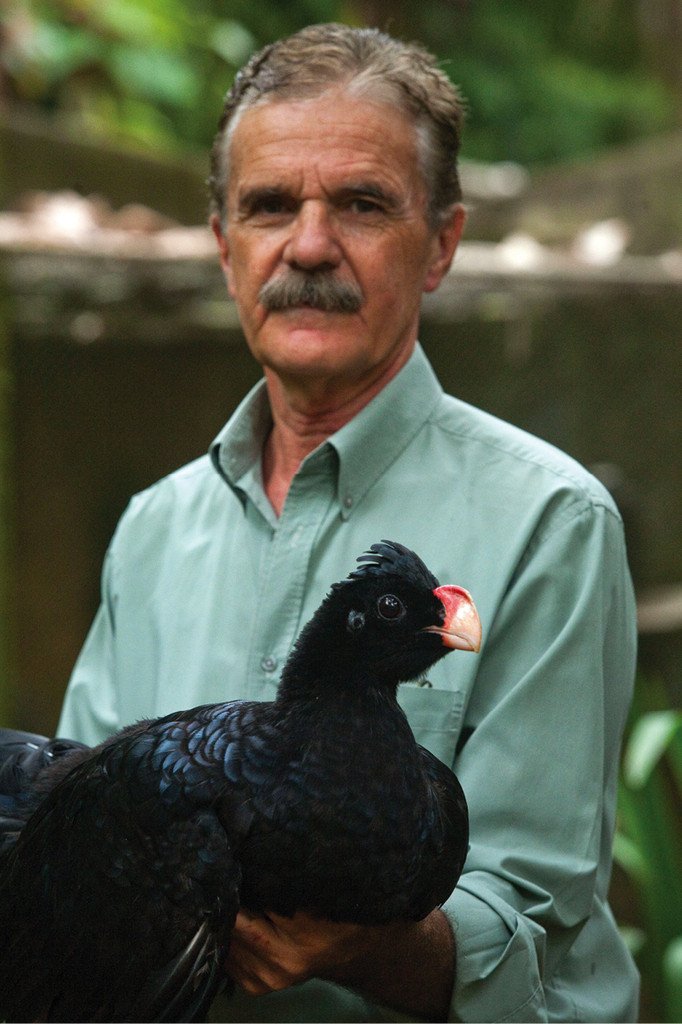
João Marcos Rosa
Breeder Roberto Azeredo is primarily responsible for the bird’s reproduction in captivityJoão Marcos RosaDespite this historical reference clearly indicating the Nassau colony’s culinary interest in the bird, the Alagoas Curassow has remained shrouded in a veil of mystery ever since then. Almost no one has seen it, and it has often been confused with the Razor-billed Curassow. “In ornithology it was a rare phantom species,” Silveira says. “In European natural history museums, the specimens attributed to the Alagoas Curassow are actually Razor-billed Curassows.” This did not prevent renowned authors from citing this Northeastern bird in their works, however. In 1766, more than a century after the Historia Naturalis Brasiliae, Swedish botanist Carl Linnaeus used Marcgrave’s information and named the bird Crax mitu, in keeping with his new binomial scientific terminology. Subsequent studies reassigned the Alagoas Curassow from the genus Crax to Pauxi.
Until the mid-20th century, there was not a single specimen of a true Alagoas Curassow in any of the world’s scientific collections. In 1951, ornithologist Olivério Pinto of MZ-USP collected a female of the species in a patch of Atlantic Forest in Alagoas and showed that P. mitu was not a myth. Pinto described the principal morphological traits of the Alagoas Curassow. The color and shape of the bill, the absence of feathers around the ear and the coloration of part of the tail are the most important traits that easily distinguish it from its Amazonian relative (see infographic). Nevertheless, the mysterious species would not come to be caught again until nearly three decades later by Pedro Nardelli, the breeder and owner of the population of Alagoas Curassows presently living in captivity.
Eight years ago, when the Ministry of the Environment launched a national plan aimed at conservation of P. mitu in partnership with universities and breeders, Francisco and Silveira had the scientific challenge of showing that pure birds of the species still existed in captivity and that it was worthwhile to invest in their preservation. That part of the job has been completed. The next step is to return pure Alagoas Curassows to their habitat. To enable this to happen soon, the researchers are partnering with the government of Alagoas and local businesses and entities. In a 900-hectare stretch of contiguous forest, a Private Natural Heritage Reserve (RPPN)—a type of conservation unit on private land—was recently established at a sugar and ethanol plant in Rio Largo, near the state capital of Maceió, to take in the first specimens of the bird. “In the past, the businesses were linked to the destruction of the forest, but today they know they play an important role in preservation of the region’s flora and fauna,” says Fernando Pinto, founder and president of the Institute for the Preservation of the Atlantic Forest (IPMA), a local entity involved in efforts to return the Alagoas Curassow to its original territory.
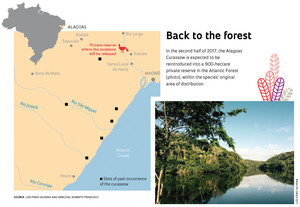 Pinto, a civil engineer, is one of the few people who have seen the bird in the wild, back in the 1970s. He even managed to photograph a female hatching eggs in a tree. At the time, he was working at an ethanol distillery and remembers having witnessed the deforestation of 10,000 hectares of forest in eight months. He had a female Alagoas Curassow in his home before donating it to Nardelli, who stayed in the area for a year and a half, looking for specimens of the bird. “Hunting is still a part of the local culture,” Pinto cautions. “That will be the greatest risk to the Alagoas Curassow after it is reintroduced. But I think we’ll be able to maintain control inside the reserve.” A visitor’s center with two specimens of the bird on exhibit is expected to be set up alongside the RPPN. This way, it will be easier for everyone to get to know P. mitu.
Pinto, a civil engineer, is one of the few people who have seen the bird in the wild, back in the 1970s. He even managed to photograph a female hatching eggs in a tree. At the time, he was working at an ethanol distillery and remembers having witnessed the deforestation of 10,000 hectares of forest in eight months. He had a female Alagoas Curassow in his home before donating it to Nardelli, who stayed in the area for a year and a half, looking for specimens of the bird. “Hunting is still a part of the local culture,” Pinto cautions. “That will be the greatest risk to the Alagoas Curassow after it is reintroduced. But I think we’ll be able to maintain control inside the reserve.” A visitor’s center with two specimens of the bird on exhibit is expected to be set up alongside the RPPN. This way, it will be easier for everyone to get to know P. mitu.
Projects
1. Studies of genetic variability of endangered Brazilian cracids (birds, Galliformes), as guidance tools for ex-situ conservation (nº 2008/ 51197-0); Grant Mechanism Research Grant – Young Investigators Awards Program; Principal Investigator Mercival Roberto Francisco (UFSCar); Investment R$327,788.81.
2. Systematics, taxonomy and biogeography of neotropical birds: The Cracidae as model (nº 2007/56378-0); Grant Mechanism Regular Research Grant; Principal Investigator Luís Fábio Silveira (MZ-USP); Investment R$86,928.28.
Scientific article
COSTA, M. C. et al. Recovering the genetic identity of an extinct-in-the-wild species: The puzzling case of the Alagoas curassow. PLOS One. In production.

